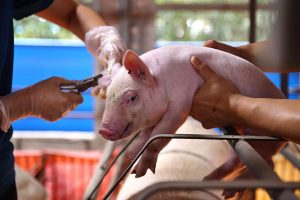HOG WEIGHTS have declined due to the intense heat brought by El Niño, farmers said.
“The performance of our pigs, of course, is also falling. So, instead of being able to grow them to 120 to 150 kilograms live weight, now, maybe, it’s like 90 to 100 (kilos) now,” National Federation of Hog Farmers, Inc. Vice-Chairman Alfred Ng told reporters.
He added that the heat brought about by El Niño has hampered feeding, resulting in lower live weights.
“This is the first time that we experienced this kind of heat, The heat index is through the roof,” Mr. Ng said.
He added that farmgate price for hogs was between 200 to 205 per kilo liveweight.
The government weather service, known as PAGASA (Philippine Atmospheric, Geophysical and Astronomical Services Administration), said El Niño-related heat and dry conditions are expected to continue despite the ongoing transition to La Niña.
Mr. Ng said farmers have no choice but to release hogs to the market when they are old enough.
“Even if you feed them, (they) don’t eat much, and they don’t grow. That’s a waste of performance,” he said.
The heat is also affecting the hogs’ resistance to disease, according to Mr. Ng.
“If they don’t eat, the pig’s immune system is also compromised. So, pag merong…mga bacterial infections na pumapasok, natamaan din sila (they are more vulnerable to bacterial infections),” he said.
Hog production declined 4.3% during the first quarter, according to the Philippine Statistics Authority. Output was around 419.94 thousand metric tons.
He added that hog farmers are continuing their repopulation efforts through the aid of the Integrated National Swine Production Initiatives for Recovery and Expansion program, following major culls to contain African Swine Fever.
The hog numbers “are just holding steady now because the weather is hot,” he said.
“It doesn’t make sense to bring animals into a farm that is too hot because the animals will only suffer,” he added. — Adrian H. Halili
